
Pioneering a New Era of Trusted, User-Centric Digital Identity
Tokyo, April 2025 – In a world where identity is the gateway to education, work, and daily life, the need for secure, user-controlled, and globally trusted solutions has never been greater. This is magnified by a world that is becoming increasingly more connected and digital. Today, TOPPAN Edge and Partisia announce a groundbreaking partnership and proof-of-concept at the Okinawa Institute of Science and Technology (OIST), aiming to redefine how digital identity works for students. This solution is a bedrock for digital identity, with applications that can span industries and use cases.
This collaboration is more than a technical integration. It’s a shared vision to bridge the familiar convenience of web2 with the trust, privacy, and interoperability of web3. By combining TOPPAN Edge’s 100+ years’ experience, including a 33% market share in Japanese ID systems, with Partisia’s advanced cryptography and blockchain solutions, the partnership is setting a new standard for privacy-first, decentralized, digital identity (DID).
Japan alone has over 813 universities, 360 of which issue IDs with IC chips (FeliCa). This involves a process that is costly, slow, and increasingly vulnerable to impersonation and fraud. Meanwhile, students already carry NFC-enabled smartphones and are accustomed to seamless, app-based, digital experiences. The challenge is to deliver a digital identity solution that is as easy to use as a tap on your phone, but as secure and private as the most advanced cryptography can provide.
At the same time, global standards are rising. The EU’s eIDAS 2.0 and Japan’s Trusted Web initiative demand solutions that are not only secure and user-centric but also interoperable across borders and compliant with the latest privacy regulations. The answer lies in a hybrid approach: leveraging the best of web2 user experience and web3’s decentralized trust infrastructure.
The OIST pilot brings together the strengths of both partners in a layered, future-proof architecture:
This hybrid model ensures that universities can adopt the system with minimal disruption, while students benefit from privacy, security, and convenience.
A key innovation of this project is the clear division of roles between Partisia Infrastructure (PI) and Partisia Blockchain (PBC):
This architecture not only future-proofs the solution but also positions it for mass adoption, both in Japan and globally.
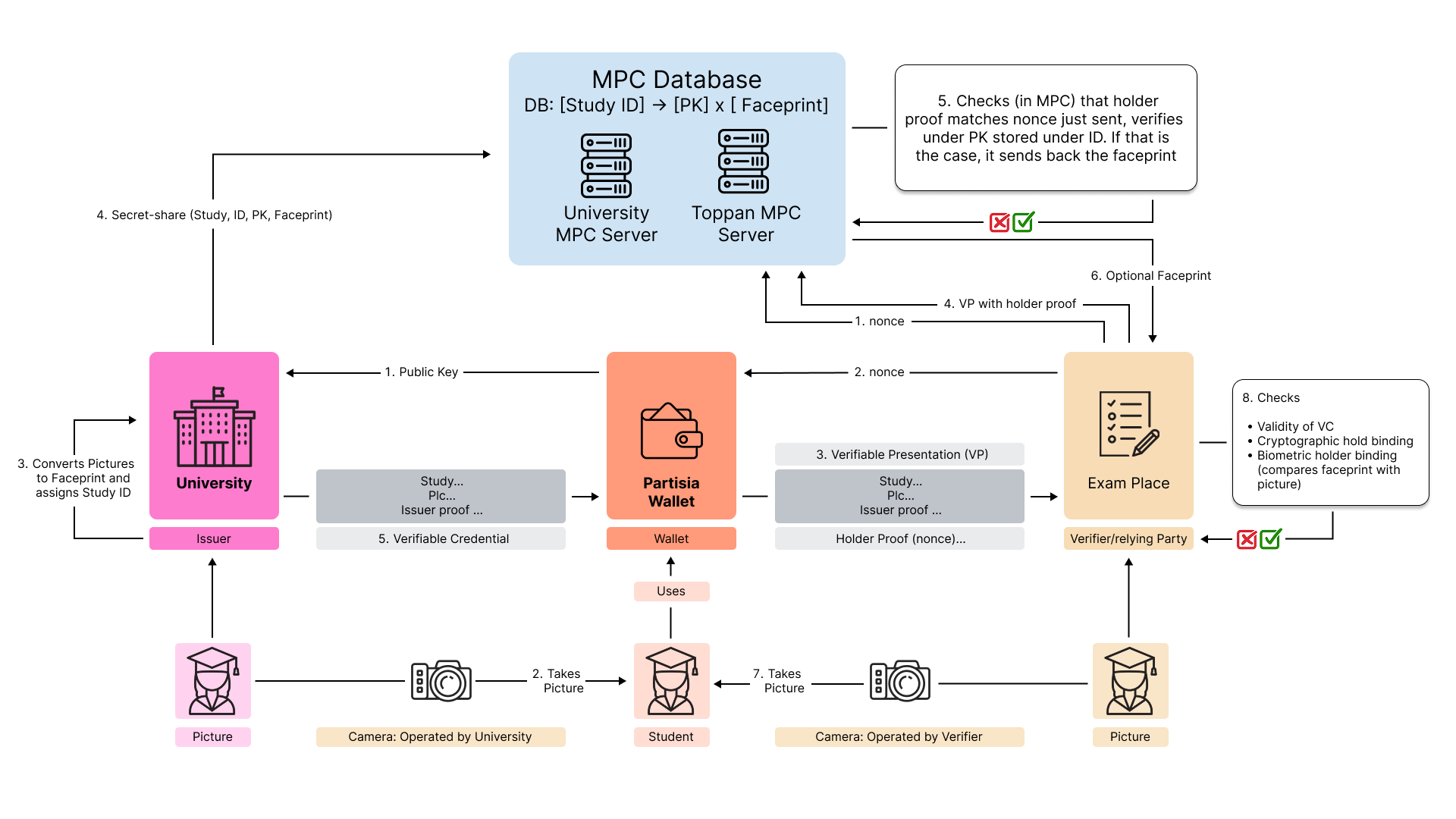
From June to September 2025, the pilot at OIST will involve up to 50 participants from the incubator facility. While the immediate focus is on access control within a university setting, the broader goal is to lay the groundwork for a scalable, privacy-first digital identity infrastructure.
This proof of concept begins with private issuance and verification to ensure the system functions seamlessly in a controlled environment. It then progresses to integration with Partisia’s public blockchain, the release of a public-facing wallet, and the deployment of an on-chain credential registry.
Crucially, this pilot is not the end state. It’s a critical foundation. The architecture being tested is designed to evolve beyond student IDs and campus access, opening the door to applications in IoT, payment infrastructure, and digital identity systems for employers, healthcare, and beyond. By anchoring this work to the Partisia blockchain, this collaboration supports the long-term goals of Japan’s Trusted Web initiative, offering a decentralized, interoperable solution where user control and privacy are built in from the start.
Key performance indicators include sub-second check-in times, zero false-accepts, and full compliance with GDPR and eIDAS audit requirements. The success of the pilot will be a critical first step in building the next generation of secure, user-centric identity systems.
The potential of this platform extends far beyond student IDs. Future applications include:
By anchoring these use cases on a public blockchain, the solution ensures interoperability, transparency, and long-term trust.
As the ecosystem grows, the Partisia blockchain will play an increasingly vital role in securing and governing digital identities. While the initial focus is on establishing a robust and user-friendly platform, future iterations may include:
These features will not only enhance the utility of Partisia blockchain but also create new opportunities for innovation and value creation.
“By fusing TOPPAN’s proven access-control hardware with Partisia’s privacy tech, we’re making the jump from Web2 convenience to Web3 trust, and setting a new global benchmark.”
Mark Medum Bundgaard, Chief Product Officer, Partisia
“This collaboration lays the foundation for a new data economy where confidential student data can finally be activated without ever being exposed.”
Kurt Nielsen, CEO & Co-founder, Partisia Blockchain
“Japan is embracing blockchain to make identity both secure and user-centric. With Partisia, privacy is built-in from day one.”
Masatoshi Oka, General Manager, ID Business Management Division, TOPPAN Edge
Building on the outcomes of the OIST pilot, the roadmap for this collaboration intends on exploring:
Institutions, developers, and regulators interested in early collaboration can find out more from our presentation at the European Identity & Cloud Conference on May 6, 2025, in Berlin.
TOPPAN Edge is a group company of TOPPAN Holdings, established in Tokyo in 1900. As a leader in digital transformation, security, and integrated solutions, TOPPAN Edge is dedicated to solving corporate and social challenges with cutting-edge approaches, including Hybrid-BPO® and advanced payment services. With a 33% market share in Japanese ID systems, TOPPAN Edge is uniquely positioned to drive the adoption of privacy-first digital identity solutions.
Partisia is a Denmark-based pioneer in privacy-preserving blockchain and secure multi-party computation (MPC). Founded by world leaders in cryptography, Partisia launched the world’s first commercial MPC solution in 2008 and now empowers enterprises and developers to build decentralized applications with privacy at their core.
Privacy isn’t an add-on; it’s in the protocol. Join us as we bring user-centric identity to every corner of the internet.
Partisia Blockchain is an innovative, public, data ownership and privacy-preserving layer-1 blockchain built for real-world utility. Combining zero-knowledge proofs and secure multi-party computation (MPC), it empowers developers and enterprises to build decentralized applications with data privacy at the core. From RWAs and digital identity to supply chain and AI, Partisia is driving the next generation of blockchain use cases across web2 and web3 industries.
Announcements can be found from our partners at Toppan and Partisia below.
Ready to build a more confidential, scalable future?
Join the us at partisiablockchain.com and on X • Discord • Telegram • LinkedIn • Facebook • Instagram • GitLab • Medium • YouTube

After much anticipation, we’re thrilled to officially announce the public launch of zkCrossDEX, the first decentralized exchange on Partisia Blockchain
Initially available as an exclusive soft launch for our Telegram community towards the end of January, zkCrossDEX has undergone numerous improvements. From backend optimizations to front-end enhancements, here’s how zkCross have refined the platform ahead of today’s public debut:
As of today, zkCrossDEX is battle‑tested but remains in Beta. It is built to learn, adapt, and grow through live usage. Your feedback and insights remain essential. You can provide any bug reports, feedback and queries directly to zkCross via the Help Centre within their DEX application.
Before you read on to learn more about this public launch and what comes next, we’d also like to share Koala Wallet is increasing the accessibility of of our programmable confidentiality omnichain layer. zkCrossDEX, but more to come, all now available at your fingertips through Koala Wallet’s multi-chain mobile wallet.
zkCrossDEX is a foundational infrastructure essential for the growth of Partisia Blockchain’s expanding web3 ecosystem. Here’s why this launch marks a pivotal moment for Partisia:
From launch, zkCrossDEX will offer powerful capabilities:
Please keep in mind that while the platform is fully operational, this launch marks a Beta phase designed to optimize the DEX based on real-world use and continuous feedback.
Joining zkCross as an early adopter is straightforward.
Remember, to pay for transaction fees on Partisia Blockchain, you have the flexibility to use BYOC assets directly or wrap MPC (via Koala Wallet and the Browser.) Koala Wallet’s guide on bridging and gas or paying for transaction fees on Partisia Blockchain is available here.
Here’s how you can get started with Koala Wallet:
*You can onboard assets into Partisia Blockchain in multiple ways currently:
We’re working with zkCross and other relevant partners on increasing accessibility and liquidity. Please bare in mind that high volume transactions will result in high slippage. We highly encourage our community to provide liquidity across the core pairs to support increase depth across zkCrossDEX.
At zkCross, community involvement is paramount. We invite you to:
“zkCrossDEX is a core building block for DeFi on Partisia Blockchain, advancing on-chain liquidity, enhancing confidentiality and cross-chain interoperability”
— Kurt Nielsen, Co-CEO and co-founder, Partisia Blockchain
To celebrate and reward early participation, zkCross will introduce an based incentive program in the near future. Here are some top level info about their program coming soon:
In addition to this, we’ll be looking at the early birds who go and use our Partner’s exchange, with the objective of providing rewards, such as MPC and [REDACTED].
We’re also working closely with the zkCross team to launch subsequent campaigns to draw users and liquidity to Partisia Blockchain.
Look out for more information soon.™️
Today’s public launch is just the start. zkCross is committed to continuous improvement and innovation:
In the coming weeks:
Looking ahead:
Get started now:
Download Koala Wallet | Try zkCrossDEX
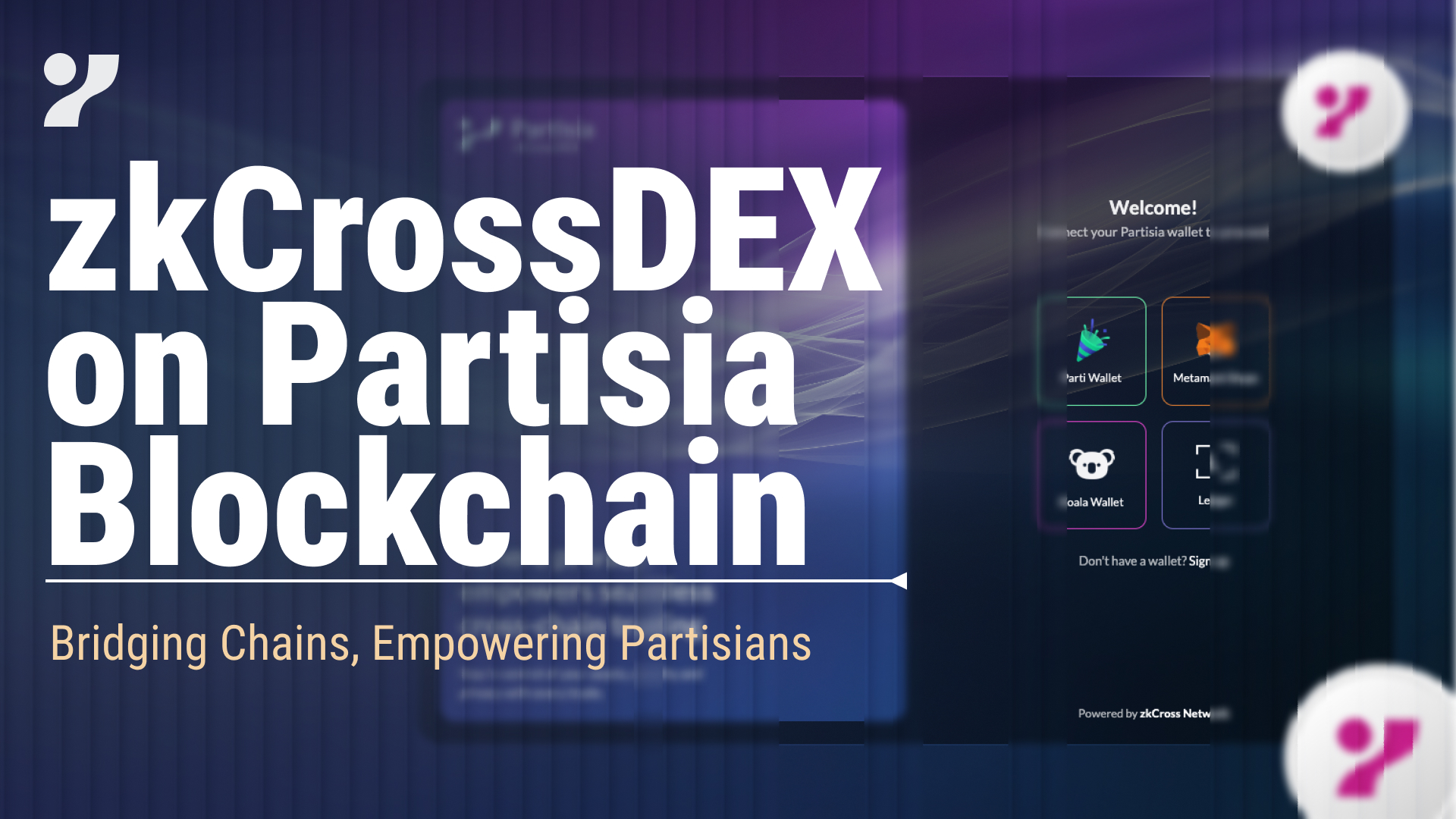
Ready to build a more confidential, scalable future?
Join the us at partisiablockchain.com and on X • Discord • Telegram • LinkedIn • Facebook • Instagram • GitLab • Medium • YouTube

Accessing the power of Partisia Blockchain just got easier.
You can now securely manage your Partisia Blockchain assets directly through the Koala Wallet mobile application. Whether you’re migrating or creating a new wallet, this integration ensures smooth, secure access to our ecosystem directly from your mobile device.
Over recent months, we’ve quietly made strides in bringing Partisia’s groundbreaking technology into everyday applications. A significant milestone in this journey is our integration with Koala Wallet, a multi-chain web3 wallet developed by Eucalyptus Labs.
This practical step is key to increasing real-world and web3 adoption of our blockchain network focused programmable confidentiality.
Web3 users want powerful features without compromising convenience. Our integration with Koala Wallet provides WalletConnect functionality, enabling easy connections on both mobile and desktop views for applications like zkCross DEX. Right now, you can seamlessly add liquidity and swap MPC and other BYOC assets directly within Koala Wallet.
Koala Wallet has recently introduced private key import functionality, making account migration from other wallets straightforward. Easily migrate your existing accounts and begin managing your assets on the most advanced wallet within our network.
No more waiting to return to your desktop to transact. With Koala Wallet, experience secure cross-chain trading and interactions wherever you are. Plus, its built-in explorer and dApp browser enable direct access to your favorite applications without leaving the app.
You can read more about the steps to importing your existing accounts by clicking here. You are also easily able to bridge any BYOC assets or wrap MPC directly within Koala Wallet – watch Koala Wallet’s video walkthrough for a quick demo.
Integrations like these are part of our broader effort to enhance Partisia Blockchain’s accessibility. By connecting with more wallets and platforms, we significantly reduce barriers to ecosystem entry.
Koala Wallet helps us reach not only seasoned web3 enthusiasts but also a rapidly growing community of mobile-first crypto adopters interested in confidentiality and performance.
Additionally, this collaboration opens doors for potential future initiatives with Eucalyptus Labs, further enriching our ecosystem.
Further in-app features will be released over time, but for now, we encourage all of our community to download Koala Wallet, explore its capabilities, and provide feedback. Your insights are crucial as we continue refining and expanding our ecosystem.
This integration is just the start of our mission to make privacy-first, interoperable blockchain technology available to everyone, everywhere.
Partisia Blockchain is a privacy-preserving, layer-one blockchain designed for real-world utility. By combining zero-knowledge proofs and secure multi-party computation (MPC), we empower developers and businesses to build decentralized apps with confidentiality at their core. From Real-World Assets (RWAs) and digital identity to supply chain and AI applications, Partisia Blockchain is leading the next generation of blockchain innovation across web2 and web3 sectors.
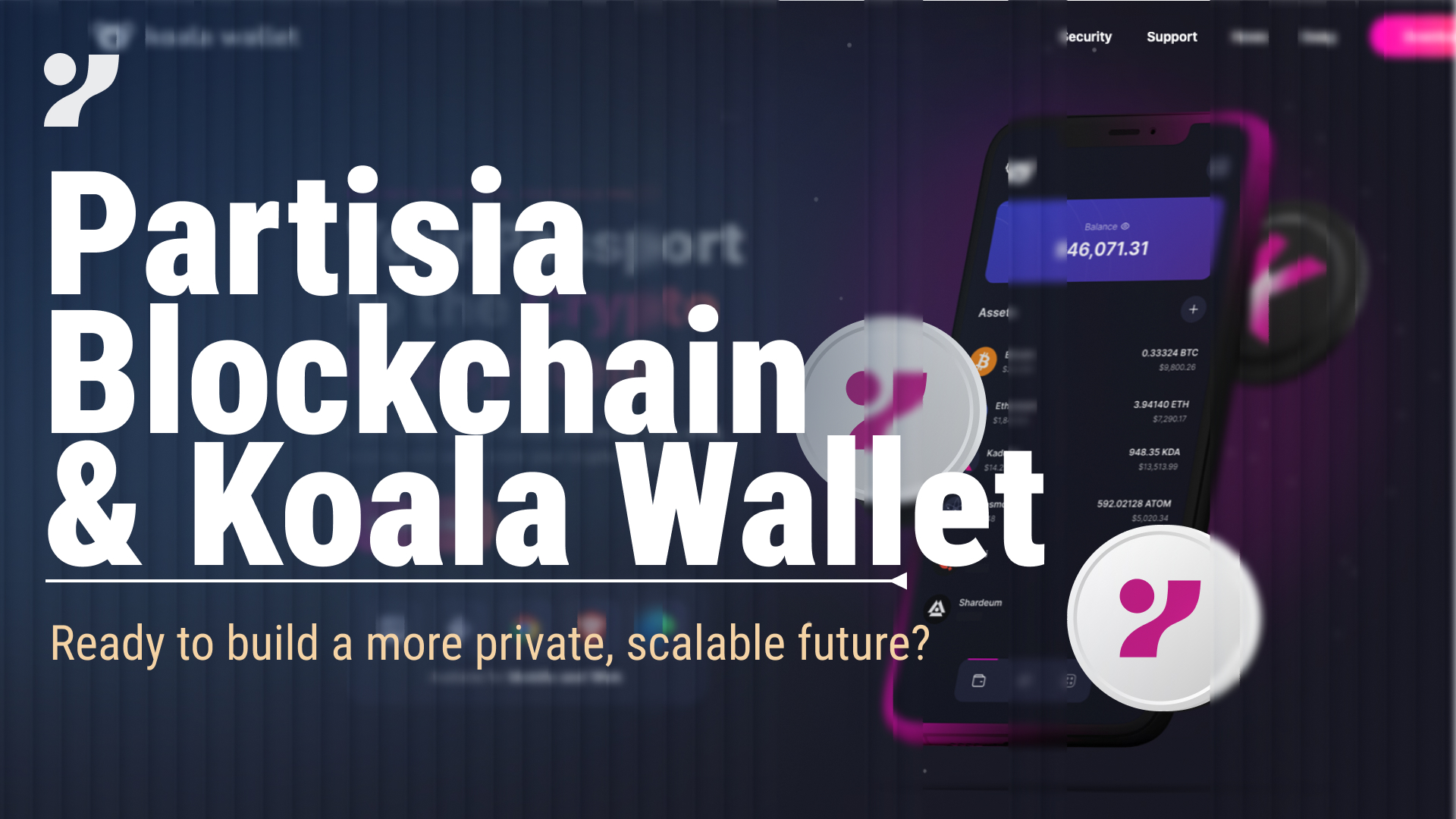
Partisia Blockchain x Koala Wallet: Bringing Programmable Confidentiality to Mobile.
Ready to build a more confidential, scalable future?
Join us at partisiablockchain.com and on X • Discord • Telegram • LinkedIn • Facebook • Instagram • GitLab • Medium • YouTube
Digital Battery Passport
Madrid, Spain – April 23, 2025 –At MOTORTEC Madrid, Partisia Blockchain today unveiled its groundbreaking Digital Battery Passport, a blockchain-enabled solution coupled with programmable confidentiality technology, co‑developed with TERA Batteries, DuoKey and Quantum Brand Protection (QBP).
Built for full compliance with EU Battery Regulation 2023/1542 (effective February 2027), this industry‑defining decentralized system fuses upgradeable NFTs, multi-party computation (MPC) key‑management and tamper‑proof physical authentication to accelerate sustainable circular‑economy models in the battery sector.
This Digital Battery Passport brings the following, to an entire continental economic area (Europe):
Kurt Nielsen, co-CEO & co-founder, Partisia Blockchain also added,
“By tokenizing batteries on Partisia blockchain, we are enabling new circular economy business models. The immutable and transparent nature of blockchain technology ensures that data integrity is maintained throughout the battery’s entire lifecycle, from manufacturing through repurposing and recycling.”
TERA Batteries, a European manufacturer of lithium-ion batteries that produces energy storage and mobility solutions with a strong focus on sustainability. Their involvement brings credibility and industry insights to the collaboration. With a direct connection to evolving battery regulation and recycling challenges, they provide a crucial link between compliance objectives and real-world application.
“Our Digital Battery Passport not only meets regulatory requirements but also provides meaningful value throughout the battery lifecycle. This collaboration brings together best-in-class technologies to deliver a secure, transparent and compliant solution for battery manufacturers.”
– David Santiago, CEO, TERA Batteries
DuoKey, a leading enterprise security provider specializing in key management and Multi-Party Computation (MPC). Its cryptographic infrastructure protects sensitive business and industrial data, allowing organizations to compute encrypted information without exposing underlying values. DuoKey ensures that battery passport data remains secure, verifiable and importantly auditable.
“The combination of DuoKey’s Multi-Party Computation technology with Partisia’s privacy-preserving blockchain creates an unparalleled security framework for managing battery data. This ensures that sensitive data remains protected while still enabling full regulatory verification”
– Nagib Aouini, CEO, DuoKey
Quantum Brand Protection (QBP) delivers cutting-edge anti-counterfeiting and authentication technologies. Their proprietary Q-Stamp system connects physical products to digital records through their tamper-proof QR codes. By providing secure markers for each battery, QBP ensures physical traceability and lifecycle authentication even in offline or recycling environments.
“This innovation provides durable, physical tamper-resistant authentication throughout the battery’s entire lifecycle, including recycling and refurbishing stages.”
– Dr. Nasser Hefiana, CEO of Quantum Brand Protection
Partisia Blockchain is next-gen public blockchain engineered for trust, privacy and speed-of-light finalization. It’s the first to combine secure multiparty computation with zero-knowledge processes and confidential smart contracts at scale, enabling a web3 with programmable confidentiality.
Maintained and developed by a Swiss Foundation, Partisia Blockchain provides the open-source infrastructure which underpins and enables the confidentiality components of the Digital Battery Passport.
This partnership provides a solution that enables stakeholders to meet and exceed the requirements of the EU Battery Regulation, whilst also opening the door to entirely new business use cases. This allows batteries to be tracked, monitored, verified and traded across different markets with reliable data baked in. It not only ensures that companies are compliant but helps manufacturers and recycling organizations unlock value from products that were previously difficult to trace. A key step in both the automotive industry and broader applications to supply chain management.
Our public blockchain network provides the following:
Live demonstrations of the Battery Digital Passport will be available at the TERA Batteries booth at MOTORTEC Madrid from April 23 to 26, 2025.
The TERA NOMAD 3R portable power station, identified with its digital passport, will be showcased, giving attendees the opportunity to experience the potential of the applied technology, which anticipates the 2027 regulatory deadline.
With this passport, we’ve proven that blockchains can be both confidential and transparent. This passport is the first real‑world asset use case that delivers on that vision at scale, transforming how regulated industries can approach compliance and sustainability simultaneously.”For more information please visit Duokey’s Medium blog here.
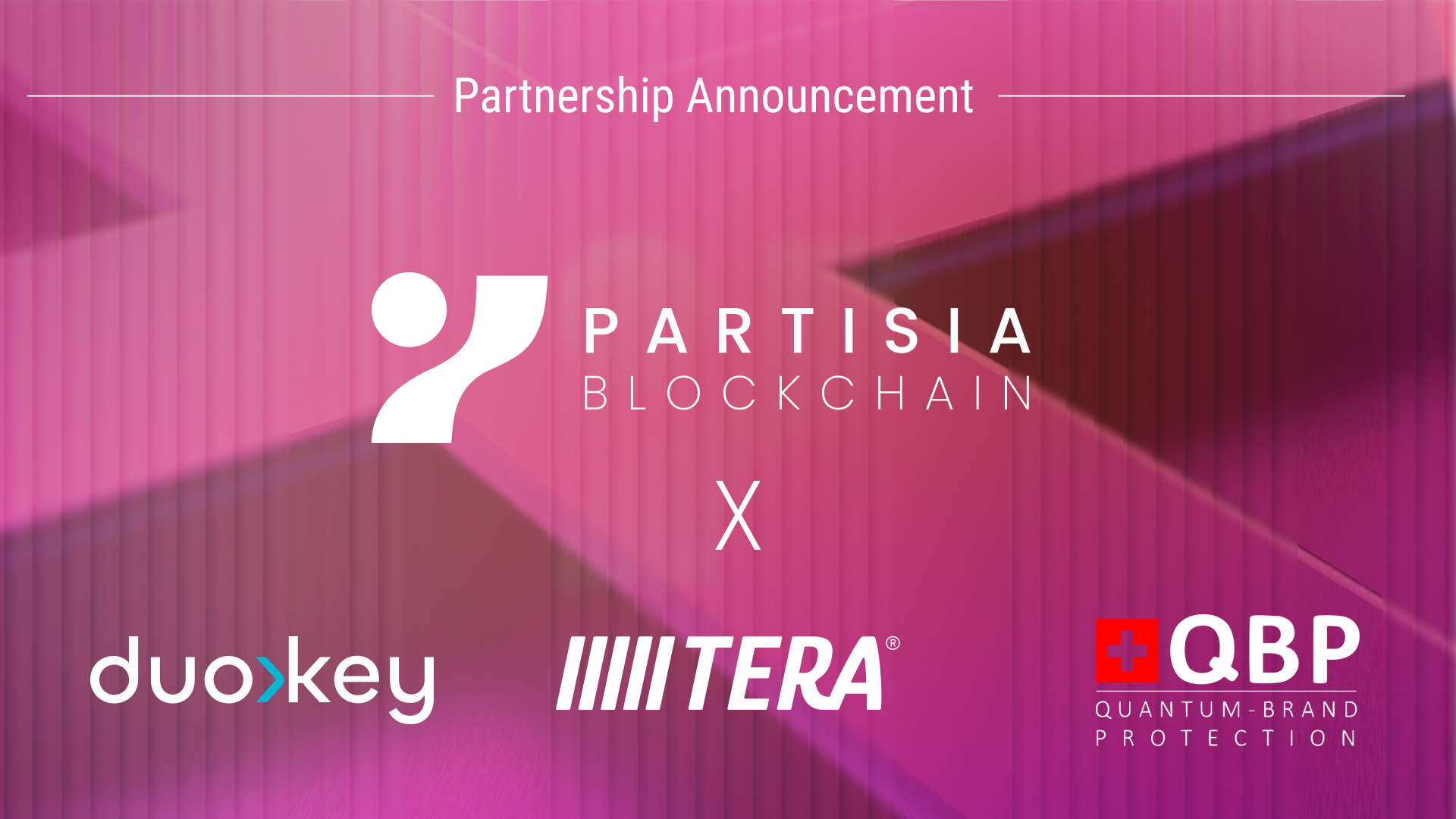
Ready to build a more confidential, scalable future?
Join the us at partisiablockchain.com and on X • Discord • Telegram • LinkedIn • Facebook • Instagram • GitLab • Medium • YouTube
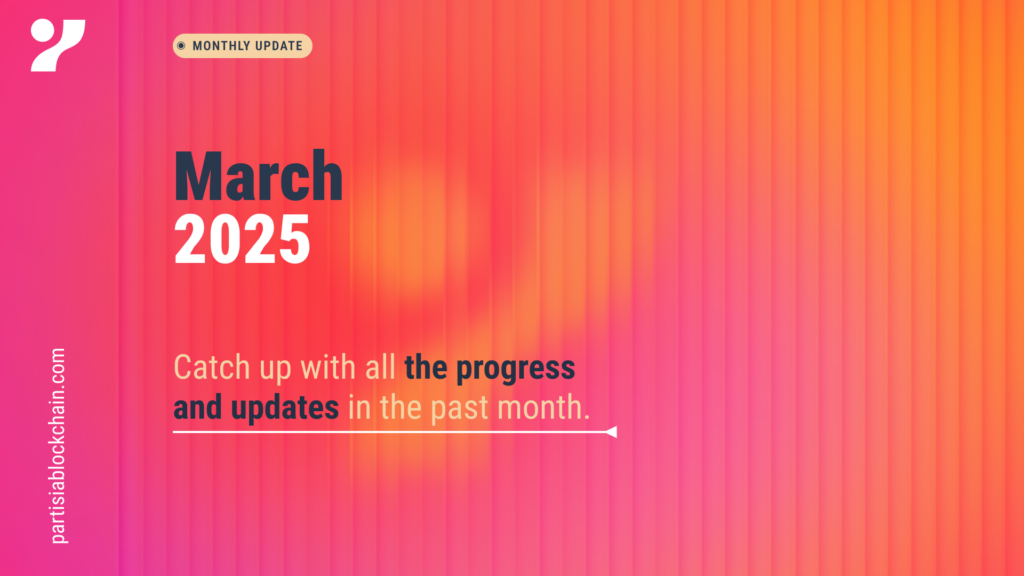
We’re excited to share the latest developments, achievements, and ongoing initiatives from March 2025, marking progress on our mission to become the leading platform for interoperable, omnichain data privacy. Here’s a full breakdown of the most important highlights across tech, ecosystem, and marketing:
Q1 Roadmap Delivered:
Foundation Laid for Scale:
Builders Gearing Up:
MPC Tooling Expanded:
zkCrossDEX Nears Launch:
Narrative Emphasized:
Stronger Community Infrastructure:
Strategic Visibility:
Read on to find out more.
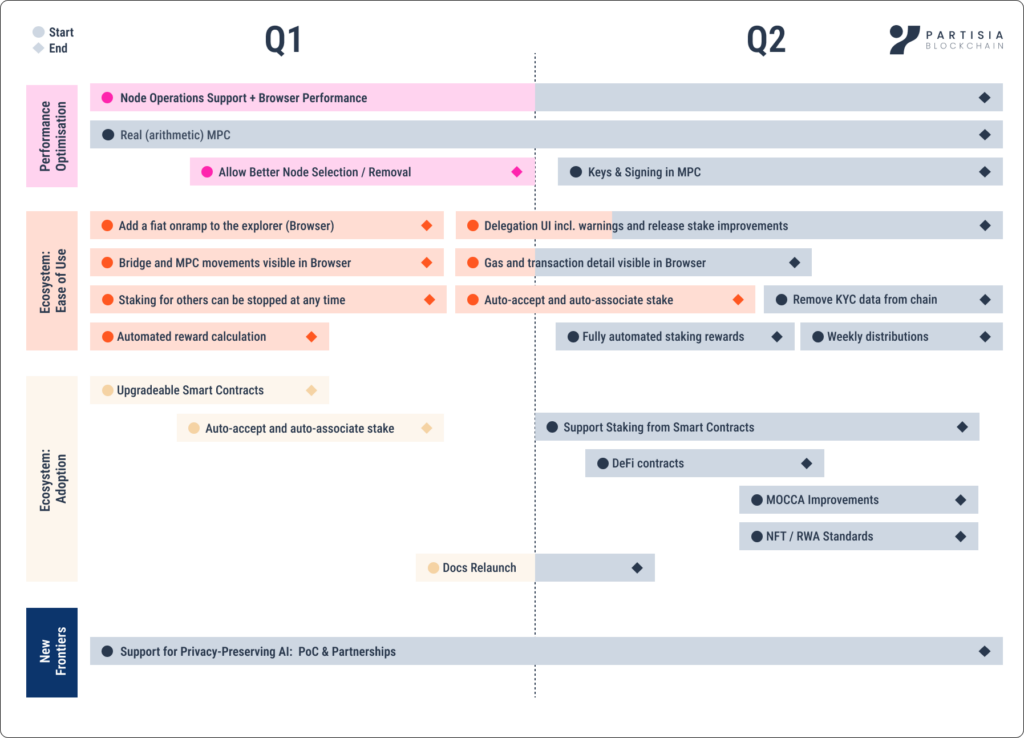
H1 2025 Technical Roadmap Progress
There have been a vast number of developments across the Browser and blockchain itself. Here are some of the key updates completed and in progress:
Our team successfully delivered all the following planned items from the Q1 segment of our H1 2025 Technical Roadmap:
Auto-Accept of Delegated Stakes:
Staking Expiry Management:
Improved Delegation UI & Management:
The delegation interface has been redesigned for clarity and fairness:
Oracle Rotation Capabilities:
ZK Registry Optimization:
WASM Off-Chain Execution:
Banking Overview Phase 2 (MPC Transfer Movements):
Browser Enhancements:
Ongoing work on the Partisia blockchain Browser:
Developer Ecosystem Enhancements:
Banking Overview Phase 3:
Further Delegation UI Improvements:
Stake Auto-association:
ZK Node Testing Enhancements:
The only remaining item from Q1 is the arithmetic MPC upgrade. This has been rescheduled to the end of Q2/early Q3 due to dependencies with our MPC key management solution (which is in high demand).
Development continued actively across several projects:
This mix of native and MPC-as-a-service decentralized Apps (dApps) reflects growing demand across chains for programmable privacy infrastructure.
These projects, and more, are anticipated to continue progressing towards their significant milestones or launches in Q2, underscoring continued momentum towards adoption.
MPC Node App and Partiscan.io simultaneously pushed essential feature updates, greatly enhancing node operator efficiency. The former is available as a mobile app for node operators, however, now they’ve opened access for all Partisia Blockchain users.
You can download the application via iOS and Android today – check it out and make sure to leave a positive review if you like what you see.
In March, we launched a series of blogs to address community questions, define our long-term vision, and clarify our strategic direction. This series served to bring coherence and clarity to the evolving identity of Partisia Blockchain:
A Connected Vision for Privacy, Interoperability, and Real Adoption
Reimagining Web3: A Vision of Privacy, Interoperability, and Real Adoption
Introducing Gods Network: Powering the Future of Web3 and Enterprise Interoperability
The Hybrid Future of Enterprise Blockchain
How Partisia Blockchain Foundation Operates and Collaborates to Drive Public Blockchain Success
Together, these articles provide the narrative structure for the next stage of Partisia Blockchain’s journey — focused on reduced friction, increased adoption, and a platform where privacy and usability are not mutually exclusive.
ETH Denver:
EPFL Panel Participation:
Moving into Q2 2025, our community can anticipate several exciting developments:
We sincerely thank you for your ongoing support and enthusiasm. Stay tuned for further exciting developments and announcements!
Stay updated: Website • X • Discord • Telegram • LinkedIn • Facebook • Instagram • GitLab • Medium • YouTube
February, though the shortest month of the year, marked a critical period of consolidation for Partisia Blockchain. Our team dedicated significant efforts to laying the foundational groundwork for upcoming launches, advancing key ecosystem initiatives, and enhancing our technical infrastructure.
This update provides a clear overview of February’s progress, including ecosystem updates, partnership developments, technical enhancements, and insights into upcoming activities.
February’s focus centered around critical preparations for upcoming launches:
The Partisia Blockchain ecosystem continues to mature, with important advancements across strategic partnerships:
Since its soft launch in late January, zkCrossDEX has significantly evolved based on extensive community testing and feedback.
An incentivized marketing campaign, featuring MPC and CROSSAI token rewards, is planned to accompany the full launch. Specific launch dates will be communicated soon, ensuring transparency and realistic community expectations.
Boosty Labs’ lending solution continues progressing steadily, targeting a public launch in the coming months.
Crowdsnap completed private survey implementations successfully on mainnet and is now very close to being ready for public launch. For more details, check out their website.
Koala Wallet will soon introduce private key import functionality, simplifying migration from Parti Wallet. Additionally, the introduction of the Brillion Wallet is expected to complement Koala Wallet, expanding our ecosystem’s wallet infrastructure.
February featured two impactful live sessions with Profila, covering decentralized identity and a live-streamed pitch showcasing their innovative solution. Profila is building on Cardano but leverages Partisia Blockchain’s omnichain confidential compute layer, highlighting our MPC technology’s cross-chain privacy capabilities.
Our team had a strong presence at ETH Denver, co-hosting an impactful MPC-focused hackathon alongside Secret Network, showcasing practical MPC applications and raising our profile in the web3 and privacy-tech community.
Key Highlights from ETH Denver:
Beyond ETH Denver, we also initiated strategic partnership discussions with Oasis Labs and Secret Network to explore potential integrations combining MPC with Trusted Execution Environment (TEE) technologies.
Furthermore, in response to the recent Safe wallet (Bybit) breach, we proactively highlighted our MPC On-Chain Custody solution as a secure and superior alternative to traditional custodial methods, reinforcing our position as leaders in blockchain security.
In February, our technical team delivered crucial updates enhancing stability, usability, and developer experience:
In addition to the above, we also delivered four key roadmap features planned for the first half of 2025.
Further details can be found here.
As we approach the end of Q1 2025, several significant milestones are on the horizon, including major launches, marketing campaigns, and reward distributions.
While timelines remain flexible to ensure high-quality deliveries, we anticipate:
Thank you for your ongoing support. We look forward to celebrating these milestones and sharing more exciting developments with you soon!
Stay updated: Website • X • Discord • Telegram • LinkedIn • Facebook • Instagram • GitLab • Medium • YouTube
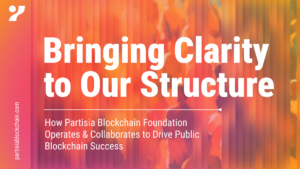
In a thriving blockchain ecosystem, clarity and synergy are paramount. Our multi-entity design ensures that each organization contributes unique expertise while remaining laser-focused on strengthening the public blockchain.
This approach—where independent companies collaborate under the governance of Partisia Blockchain Foundation (PBF)—is a proven model seen in other blockchain ecosystems, such as Cardano’s relationship with the Cardano Foundation, IOHK, and EMURGO.
By upholding financial independence, robust governance, and a shared commitment to the success of PBF, we guarantee that every initiative ultimately serves the Partisia Blockchain community—driving adoption, innovation, and long-term success for the public network.
To provide a clear understanding of how these entities work together, here is a high-level breakdown of their roles:
Each of these companies operates independently but plays a distinct role in strengthening the public blockchain ecosystem under the governance of PBF. Below, we provide a more comprehensive overview of their contributions and governance structures.
At the core of the ecosystem is the Partisia Blockchain Foundation (PBF), a Swiss non-profit entity responsible for governing the public blockchain’s development, adoption strategy, and ecosystem growth. The foundation is the guardian of the public blockchain, ensuring that it remains open-source, transparent, and accessible for developers, enterprises, and the broader web3 community.
PBF was established in 2020, following an extensive regulatory process to ensure compliance with Swiss financial authorities and alignment with utility token regulations. This regulatory foundation remains a key pillar of the project’s long-term legitimacy and governance.
PBF follows a strict governance model, supervised by the Swiss ESA and is subject to rigorous audits and financial oversight. It operates under a locked-purpose structure, meaning its funds can only be used to develop, promote, and bring the public Partisia Blockchain to market.
The development of Partisia Blockchain dates to March 2017, when the first lines of code were written by Partisia Infrastructure (PI). PI played a critical role in shaping both the technical architecture and regulatory framework, ensuring compliance with Swiss utility token regulations. The early development efforts culminated in Version 1.7, which was acquired and open-sourced by PBF in October 2020, leading to the public release of Version 2 in January 2021.
The Foundation plays a crucial role in strategic planning, ensuring that the blockchain evolves in line with its mission. The original roadmap was set out in the whitepaper, with a yearly roadmap review that is subject to quarterly replanning. The latest iteration was a 6-month roadmap, completed in January 2025.
Although independent companies like PI and GN Solutions (GN or GODS Network), contribute to blockchain development, PBF remains the governing entity, ensuring that public blockchain progress remains transparent, decentralized, and independent from private interests. As governance continues to evolve, efforts are underway to explore more community-driven governance models.
While PBF remains the central governing entity of the public blockchain, several independent companies contribute technical expertise, adoption strategies, and infrastructure. Below, we outline their roles and how they align with PBF’s mission.
Partisia Infrastructure (PI) is an independent Danish company specializing in blockchain solutions, encryption, and privacy-preserving cryptography. However, its role in the ecosystem goes beyond enterprise applications—it has been a driving force behind the technical foundation of the public blockchain since its inception.
Partisia Infrastructure (PI) is the dedicated core developer team and technological brain trust behind the public blockchain. With over a decade of expertise in advanced cryptography, multi-party computation (MPC), and blockchain technologies, PI played a pivotal role in shaping the public blockchain’s whitepaper, regulatory framework, and token classification. As part of a larger group of independent Partisia companies that existed long before the blockchain’s launch, PI operates independently, generating its own revenue through private-sector contracts and projects ranging from quantum computing security to MPC-based key management (via Sepior, now a Blockdaemon company).
PI was responsible for building the core mainnet protocol, leveraging its deep cryptographic expertise to ensure a secure, scalable foundation for the blockchain. This work was delivered at a heavily discounted rate, underscoring PI’s commitment to the success of the public blockchain.
Since then, PI has remained the core development company behind the public blockchain, responsible for:
Beyond development, PI also plays a key role in enterprise adoption, acting as a go-to-market (GTM) partner for businesses transitioning to web3. By working with enterprises on private blockchain solutions, PI is often able to guide them toward the public blockchain, increasing on-chain activity and adoption.
Despite its involvement in development and enterprise solutions, PI operates independently from PBF, with strict governance ensuring that no public blockchain funds are used for private enterprise projects.
GODS Network is a Swiss-based entity established by Partisia Group—the same company that owns Partisia Infrastructure. It was created to solve a major challenge in web3: fragmentation across blockchain ecosystems.
By acting as an interoperability layer built directly on Partisia’s public blockchain, GODS Network connects disparate blockchains into a unified, seamless infrastructure, allowing data and transactions to flow across networks effortlessly.
At its core, GODS Network functions as a decentralized data subscription layer, enabling any smart contract on any blockchain to publish and subscribe to data across chains. This removes the silos between EVM and non-EVM blockchains, making decentralized applications more accessible and functional. The integration also enables Partisia’s public blockchain to provide privacy-preserving computation as a commodity across multiple chains, offering a unique value proposition in the web3 ecosystem.
While GODS Network is built by Partisia Infrastructure, it operates as a completely independent entity. It receives no funding or grants from Partisia Blockchain Foundation (PBF), ensuring a clear financial separation between GODS Network and the foundation. However, there is close collaboration between GN and PBF on business development, ensuring that GODS Network’s innovations directly drive adoption for the public blockchain.
One of the most significant benefits of GODS Network is that any use of its interoperability features will generate on-chain transactions on Partisia Blockchain. This means that while GODS Network operates independently, its success directly contributes to network activity and revenue generation for Partisia Blockchain node operators. By bridging blockchains and enabling seamless cross-chain transactions, GODS Network is positioned to be a key driver of Partisia Blockchain’s adoption in the broader web3 space.
PBC Apps is a Cayman Islands-based company founded by Brian Gallagher, a former co-founder and previous member of the Foundation Council. As part of the natural evolution of the ecosystem, Brian stepped away from day-to-day involvement with the foundation, shifting his focus to external adoption initiatives outside of PBF.
Originally, PBC Apps played a key role in driving early web3 adoption on Partisia Blockchain, leveraging its expertise to support ecosystem growth and infrastructure development.
The company was engaged in an arm’s length development agreement to build and maintain core ecosystem tools, including the initial explorer and Parti Wallet, which was—until recently—the only available wallet in the Partisia ecosystem.
Over time, the blockchain has expanded beyond a single provider, introducing new wallet solutions and enabling broader developer participation.
Today, PBC Apps operates entirely independently from the foundation and receives no further payments from PBF, originally required to build core infrastructure like wallets. It functions as a third-party service provider, just like any other independent vendor in the ecosystem, with no exclusivity or preferential treatment. This transition reflects the maturity of the public blockchain ecosystem, moving towards a more decentralized and competitive infrastructure landscape.
Ensuring strong governance and alignment between all companies in the ecosystem is a key priority for the Partisia Blockchain Foundation (PBF). The focus is not just on legal compliance, but on ensuring that every entity involved operates in a way that benefits the public blockchain and serves the long-term vision of the ecosystem.
From the very beginning, PBF was designed with a governance structure that prioritizes independence and accountability. Before the foundation was formally established, the co-founders worked extensively with Swiss regulators to ensure that the blockchain’s design met Utility token regulatory standards. This regulatory groundwork—combined with the development of the initial network version and the publication of the whitepaper—laid the foundation for how PBF would be structured.
To ensure that development efforts remained aligned with the public blockchain’s success, arms-length agreements were put in place with both Partisia Infrastructure and PBC Apps. These agreements were carefully structured and reviewed by an independent third party, ensuring that any services provided by external entities adhered to market standards and fair governance principles.
As PBF continues to evolve, governance remains an area of active development and refinement. The foundation operates under strict Swiss ESA supervision, undergoing annual audits that have consistently resulted in high compliance rankings with no critical issues. However, beyond regulatory adherence, the real measure of good governance is whether the relationships between entities in the ecosystem ultimately benefit the public blockchain and its stakeholders.
Instead of forcing a premature shift toward decentralized governance, the focus will remain on ensuring that the right governance mechanisms are in place to support the blockchain’s long-term success. As part of this commitment, the foundation’s council is actively exploring options to move toward a more community-centric governance model, including community representation on the council and a DAO model. These avenues would ensure that the public blockchain’s governance becomes more decentralized, balanced, and inclusive, with stronger representation from the community.
While the governance structure will continue to evolve over time, these options aim to strengthen transparency, accountability, and community involvement in decision-making. Should a clear route, requirement, and environment for these ideas arise in the future, it will be driven by community demand rather than imposed as a governance model for its own sake.
Governance improvements will be introduced gradually, ensuring that shifts toward decentralization are well-planned and beneficial to the network.
The Partisia Blockchain Foundation (PBF) is committed to building a sustainable, high-impact public blockchain. The separation of roles and responsibilities allows each organization to focus on its core strengths, ensuring that PBF remains dedicated to governance, adoption, and ecosystem growth while benefiting from technical expertise, interoperability advancements, and infrastructure contributions from aligned entities.
The public blockchain remains at the centre of this ecosystem, and PBF continues to explore opportunities to evolve its governance model to increase community involvement.
Partisia Blockchain is entering a new phase of growth, accountability, and execution, and we are excited to move forward together with the community toward a stronger, more decentralized future.
Dive deeper into the other relevant topics here:
Stay updated: Website • X • Discord • Telegram • LinkedIn • Facebook • Instagram • GitLab • Medium • YouTube

In today’s fragmented web3 landscape, hundreds of blockchains operate as isolated silos—each with its own language, protocol, and consensus. This complexity creates daunting challenges for developers, enterprises, and users, hampering innovation and impeding secure, seamless data exchange. True interoperability remains the holy grail of web3.
GODS (Global Omnichain Data Service) is a breakthrough interoperability protocol that transforms complex cross-chain interactions into a simple, secure, and cost-effective subscription service. By enabling decentralized applications (dApps) to “listen” to events across diverse blockchains, GODS Network empowers innovation, drives enterprise integration, and fuels the growth of the Partisia ecosystem—all while upholding the vision of a decentralized, user-centric future where privacy and data control are paramount.
GODS Network envisions an “Internet of Blockchains” where data and assets flow effortlessly between networks. Its mission rests on three key pillars:
1. Breaking Down Barriers:
2. Transforming Interoperability
3. Security & Trust
Think of GODS Network as a universal remote control that can work with any device in your home – eliminating clutter and complexity. That is the promise of GODS Network for web3:
Every operation—from subscription initiation to MPC validation—is recorded on the public Partisia Blockchain. This transparency builds trust and allows anyone to audit the system in real time.
Distributed key management among a large number of MPC nodes means that even if some nodes are compromised, the integrity of cross-chain transactions remains intact. This state-of-the-art approach reduces the risk of a single point of failure.
Acting as a universal translator, GODS seamlessly connects EVM-based chains like Ethereum with non‑EVM chains such as Partisia Blockchain, Cardano, and Solana. Developers can integrate data from multiple sources without juggling different codebases or SDKs.
Much like calling a familiar API, developers can easily subscribe to on-chain events without writing complex bridging logic. This simplicity accelerates development and reduces operational overhead.
With a pay‑as‑you‑go model and the use of Merkle tree proofs to batch updates, GODS significantly lowers gas costs—a major advantage for high-frequency applications.
As the web3 landscape matures, interoperable data and assets become increasingly critical. Here are some real-world applications that demonstrate GODS Network’s transformative potential:
Many enterprises are eager to explore web3 but are slowed by complexity and fragmentation. GODS Network functions as a secure, transparent decentralized API that bridges legacy systems with modern blockchains. Imagine a supply chain platform where internal logistics run on a private network while payment settlements occur on multiple public blockchains—the integration made effortless by GODS Network.
Think of GODS Network as the API that connects secure enterprise systems with the decentralized world—a solution that bridges legacy and innovation seamlessly.
GODS Network is a critical pillar within the broader Partisia Blockchain ecosystem, reinforcing our shared vision of a decentralized, privacy-focused future:
Bridging Public and Private Networks
Driving On-Chain Activity
A Synergistic Ecosystem
At Partisia Blockchain, our vision is to reimagine web3 by “doing for data what Bitcoin did for money.”
We are committed to creating a decentralized network where privacy, interoperability, and real adoption coexist. GODS Network is the embodiment of that vision—an innovative interoperability layer that transforms a fragmented landscape into a unified digital infrastructure.
GN Solutions AG (the company behind GODS Network) is a Swiss-based entity established by Partisia Group—the same organization behind Partisia Infrastructure. Created to address the fragmentation of blockchain ecosystems, GODS enables any smart contract on any blockchain to publish and subscribe to data seamlessly.
Although built by Partisia Group, GODS operates independently and receives no funding or grants from the Partisia Blockchain Foundation, ensuring clear financial separation while benefiting from close business collaboration.
Every use of GODS Network’s features generates on-chain transactions on Partisia Blockchain, contributing to network activity and revenue. In this way, GODS plays a key role in advancing the broader web3 ecosystem while maintaining its distinct identity.
Read more about the different entities within the Partisia ecosystem here.
GODS Network offers a compelling vision for the future of blockchain interoperability. By transforming cross-chain data exchange into a secure, subscription-based service, it empowers developers, accelerates enterprise adoption, and drives the growth of the Partisia ecosystem.
Together with Partisia Blockchain’s commitment to privacy and robust cryptography, GODS Network is poised to make a fragmented landscape truly unified and accessible.
We hope you enjoyed our introduction and exploration of the potential of GODS Network.
Stay tuned for more updates and join our upcoming AMAs to learn more about how GODS Network is powering the future of web3 and enterprise interoperability.
Dive deeper into the other relevant topics here:
Stay updated: Website • X • Discord • Telegram • LinkedIn • Facebook • Instagram • GitLab • Medium • YouTube

Blockchain technology is widely heralded as a transformative force for enterprise – from streamlining supply chains and enhancing financial processes to securing digital identities. It promises to radically improve how organizations manage data, trust, and transactions. Yet, many enterprises remain cautious about fully embracing public blockchain solutions because of concerns around security, scalability, privacy, control and regulatory compliance.
A compelling answer lies in a hybrid blockchain model – one that combines the best aspects of private (permissioned) and public (permissionless) networks. By integrating the control and confidentiality of private systems with the transparency and decentralization of public chains, enterprises can safeguard sensitive information while benefiting from global trust and interoperability.
Coupled with advanced solutions like the GODS Network, this approach not only addresses critical enterprise challenges but also drives broader public chain adoption.
It is important for us to outline what private and public blockchains are. This sets the groundwork for understanding why a hybrid model is best suited to catalyse enterprise adoption for the public blockchain network.
Characteristics:
Drawbacks:
Examples in practice:
Characteristics:
Drawbacks:
Examples in practice:
Think of a traditional bank. You access your account via a public app over a public network, but behind the scenes, the bank’s internal systems are protected by a secure intranet. Sensitive data like HR records or proprietary processes remain hidden, while only essential transaction data (like your account balance) is visible externally.
In web3, a private blockchain functions as this intranet, allowing sensitive computations to be kept confidential. Meanwhile, key outcomes—such as transaction confirmations—can be recorded on a public chain, ensuring transparency and immutability.
Large organizations often balk at placing any data on a fully public ledger—even if encrypted—due to regulatory constraints, internal policies, control, and privacy concerns. By offering a private network that seamlessly interfaces with a public chain, enterprises can:
It might seem counterintuitive, but as enterprises deploy private blockchains to manage sensitive data, they naturally generate key events—such as transaction finalizations—that can be recorded on public chains for greater transparency.
These on-chain records not only verify the private process but also bring real-world validation and transaction volume to the public ecosystem. Over time, this interplay boosts the credibility and adoption of public blockchains while enterprises get comfortable on the private side.
Multi-Party Computation (MPC) is a critical technology that enhances security by allowing multiple parties to compute functions over their data without revealing the inputs. In a hybrid model:
Decentralized MPC:
Centralized MPC:
Hybrid MPC Approaches:
GODS Network further the migration from enterprise blockchains to any public blockchain by not locking migration to a single public blockchain. It’s designed as a cross-chain data subscription layer that seamlessly connects disparate blockchains—whether private or public—through a simple, API-like interface. Here’s what makes GODS Network unique:
A hybrid blockchain model is the most practical solution for onboarding web2 enterprises into the web3 world. By keeping sensitive data and internal processes on a private network while using public chains for key transactions, enterprises can:
As enterprises increasingly migrate to hybrid frameworks, they generate a wealth of validated public transactions that enhance the overall credibility and interoperability of blockchain networks. Platforms like GODS Network embody this vision by offering a secure, scalable, and developer-friendly bridge that not only protects sensitive data but also catalyzes broader public chain adoption.
The journey toward enterprise blockchain adoption has been deliberate and measured, with enterprises seeking solutions that balance privacy, control, and regulatory compliance against transparency and decentralization. Hybrid blockchain models effectively bridge this gap by combining the best elements of private and public blockchains, delivering secure, scalable solutions that enterprises can comfortably adopt.
The banking analogy illustrates how internal systems (the “intranet”) can coexist with public interfaces, enabling both confidentiality and auditability. GODS Network enhances this hybrid approach by seamlessly connecting private and public infrastructures, streamlining cross-chain interactions and simplifying overall user experience. It is an essential tool for facilitating smooth integration and interaction.
As enterprises build confidence in this hybrid model, they will drive increased public chain activity, ultimately creating a robust, interconnected web3 ecosystem.
Dive deeper into the other relevant topics here:
Stay updated: Website • X • Discord • Telegram • LinkedIn • Facebook • Instagram • GitLab • Medium • YouTube